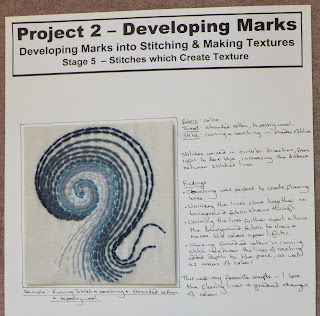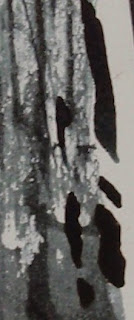In Stage 5 we are asked to use stitches which create texture and to explore the effects of the stitch, to vary the density and create rich effects.
Initially I used hand embroidery, the stitch chosen was satin stitch.
Threads: Stranded cotton, Tapestry wool, Cotton perle.
The fabric: Calico stretched on an embroidery hoop.
This is the first sample:
I worked thick, tapestry wool threads against fine stranded cotton, and, matt yarn - tapestry wool against shiny cotton perle.
I worked blocks of stitches in a horizontal direction, against blocks of stitches worked in a vertical direction.
Some of the stitches were arranged in diamond shapes.
The colour changed from grey to light blue to a darker bluey grey.
 |
| Sample 1: satin stitch using a variety of colours and threads |
The thicker, smoother cotton perle thread showed up the structure of the stitch best - but because of the sheen of the thread, also reflected the most light.
The stranded cotton has the smoothest texture.
When the stitches were arranged horizontally and vertically, they appeared to have a flat surface; when the stitches were arranged in a diamond shape, the stitches appeared to undulate across the surface - receding into the middle of the diamond.
The roughness of the tapestry wool meant that the individual stitches were less distinct than the smoother threads.
I really like this sample, it is rich in colour and texture.
---------------------------------
Sample 2:
Method: I used hand embroidery, the stitch chosen was satin stitch.
Threads: Stranded cotton, artificial silk.
The fabric: Calico stretched on an embroidery hoop.
I used thicker silk threads and a finer stranded cotton in a single colour: green.
I worked blocks of stitches in a single direction, each block had a different quantity of stitches in them.
 |
| Sample 2: Satin stitch using silk and stranded cotton threads |
The larger the quantity of stitches in each block - the further away and darker, the block of stitches appeared to be, they appear to recede.
The fewer quantity stitches in each block made the block appear larger and brighter and nearer.
The silk threads appeared to be closer and darker, they were shinier and drew the eye in.
The sample was interesting to make, and it was a pleasure to work with the silk thread (even if it was an artificial silk!).
--------------------------------------------------
Sample 3:
Method: I used hand embroidery, the stitch chosen was running stitch.
Thread: Stranded cotton.
The fabric: Calico stretched on an embroidery hoop.
I used stranded cotton in a single colour: grey.
I worked stitches in a single direction, changing the size of the spaces between each stitch, and between each row.
 |
| Sample 3: running stitch using stranded cotton |
The further apart the stitches and rows were - the nearer that part of the fabric surface appeared to be.
The closer together the stitches and rows were - the further away that part of the fabric surface appeared to be.
The thread colour appears darker when the density of the stitches is heavier.
I liked this sample - the fabric and the stitches are flat and smooth and yet the stitched sample appears curved like a tree trunk (when looked at rotated 90 degrees)..
----------------------------------------------------
Sample 4:
Method: I used hand embroidery, the stitch chosen was running stitch.
Thread: Stranded cotton.
The fabric: Calico stretched on an embroidery hoop.
I used stranded cotton in a single colour: grey.
I worked stitches in a multiple directions, this changed the density of the stitches across the surface.
 |
| Sample 4: running stitches using stranded cotton |
The denser the stitching - the darker the colour of the thread.
The stitches worked in this way added texture to the surface of the background.
It would be interesting to take this sample further, changing the colours of the thread to see what other effects this creates.
-----------------------------------------------------
Sample 5:
Method: I used hand embroidery, the stitch chosen was herringbone stitch.
Thread: Stranded cotton.
The fabric: Calico stretched on an embroidery hoop.
I used stranded cotton in a single colour: light grey.
I worked stitches in a single direction, altering the spacing and quantity of stitches in each column.
 |
| Sample 5: Herringbone stitches in stranded cotton |
The further apart the stitches are in each column - the lighter the thread appears.
The more densely spaced the stitches - the darker the thread appears.
Changing the colours of thread would also affect the dark and light side of the stitch.
Once the embroidery hoop was removed from the fabric, the stitches appeared to be loose - almost floating on the fabric surface - a nice textural effect.
------------------------------------------------------
Sample 6:
Method: I used hand embroidery, the stitch chosen was long running stitch.
Thread: Stranded cotton and artificial silk.
The fabric: Calico stretched on an embroidery hoop.
I used stranded cotton and art silk in a single colour: green.
I worked stitches in a multiple directions, starting with the stranded cotton, working over with silk, then finishing with the stranded cotton.
 |
| Sample 6: long stitches in art silk and stranded cotton |
The use of just one single colour allowed the qualities of the threads to show up. The silk being thick, shiny and lustrous, against the duller, finer stranded cotton.
Again, the density of the stitching created dark and light areas of stitches.
Once the silk thread had been stitched - the stranded cotton could hardly be seen - this was rectified by overstitching with the stranded cotton once more.
I liked using the longer stitches, they created good directional lines and movement.
------------------------------------------------------
Sample 7:
Method: I used hand embroidery, the stitch chosen was long running stitch.
Thread: Stranded cotton.
The fabric: Calico stretched on an embroidery hoop.
I used stranded cotton in complimentary colours: red and green.
I worked stitches in a multiple directions, starting with the green stranded cotton, then working over with the red stranded cotton.
 |
| Sample 7: long running stitches in stranded cotton |
The denser the stitches - the darker the colour the thread appears.
This was the only sample where I looked at the effects of colour in the sample - all the others used either the same colour or a harmonious range of colours.
---------------------------------------------------
Sample 8:
Method: I used hand embroidery, the stitch chosen was running stitch and couching.
Thread: Stranded cotton and tapestry wool.
The fabric: Calico stretched on an embroidery hoop.
I used stranded cotton and tapestry wools in different blues.
I worked stitches in a circular direction, going from light to dark shades of blue, increasing the distance between the stitched lines.
 |
| Sample 8: running stitch and couching in stranded and tapestry wool. |
When the lines were close together, no background fabric showed through.
As the lines were made further apart, fabric showed through and it became lighter.
Stranded cotton being stitched between the lines of couching added depth to the piece, as well as adding shadows of colour.
This was my favourite sample to make - I like the flowing lines and the gradual changes of colour.
-----------------------------------------------------
I feel happy that I have a visual record of stitch textures to refer to for the forthcoming exercises.
I have enjoyed making these samples, although they took a long time to create. I should have reduced the stitching area, this would have reduced the time spent on them.
Although the last sample was my favourite one to stitch, I really liked the optical illusions created by stitching samples 2 and 3.
By stitching closely together and then far apart, the stitches looked nearer and then further away.
I know that I need to create a sample to relate these effects to, only then will they start to really make sense to this part of the project. I am going to look back through my work and sketches to find the right drawing to do this with.
---------------------------------------------
The finished pages
 |
| Stitches which Create Texture - 1 |
 |
| Stitches which Create Texture - 2 |
 |
| Stitches which Create Texture - 3 |








































